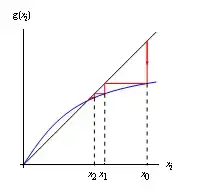I have got the following problem:
Examine why the following sequence is well-defined, determine whether it is a monotonous sequence and calculate its limit:
$$a_0 = 3, a_{n+1} = \sqrt{2a_n - 1}$$
Now just by looking at this sequence and checking its first few entries it seems obvious that it is strictly decreasing. I then proved this with induction. Now I'm trying to find the limit, it seems obvious that its $1$, but I have been struggling to prove this. Since I know the sequence is strictly decreasing I looked at the following:
$$a_n > a_{n+1}$$ $$a_n > \sqrt{2a_n - 1}$$ $$a_n^2 > 2a_n - 1$$ $$a_n^2 - 2a_n + 1 > 0$$ $$(a_n - 1)^2 > 0$$
From this we get that $a_n > 1$ for all n. Would this be a correct proof that the limit of the sequence is 1? And as for whether the sequence is well-defined, since all entries are bigger that $1$ the square root will never have negative input, so it would be well-defined. Would this also be correct?
